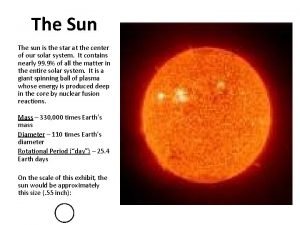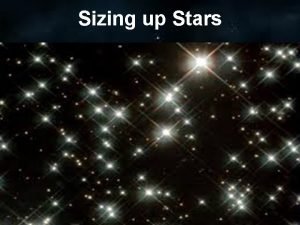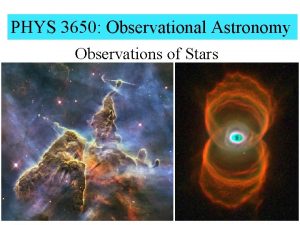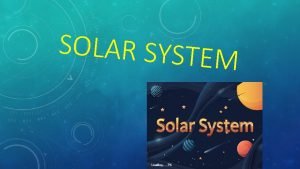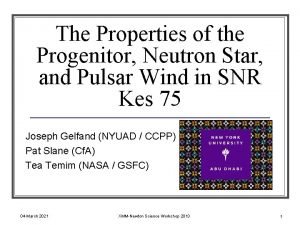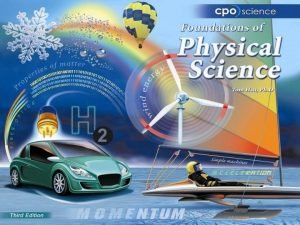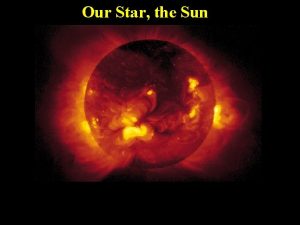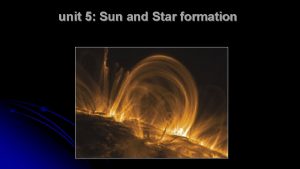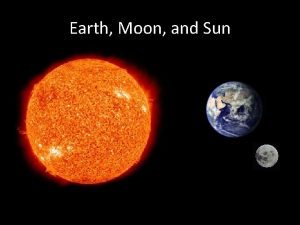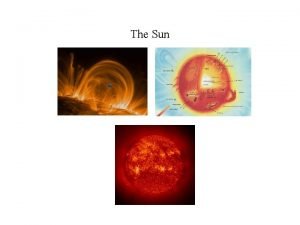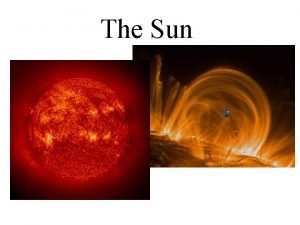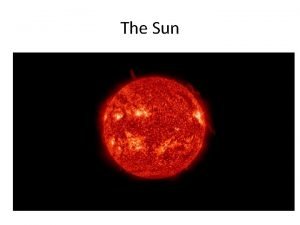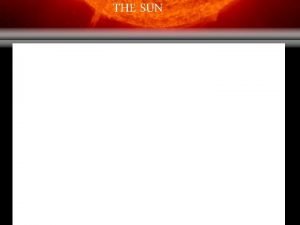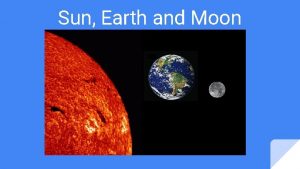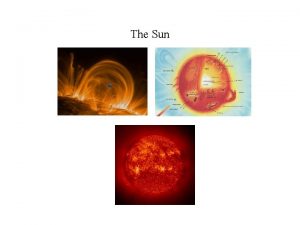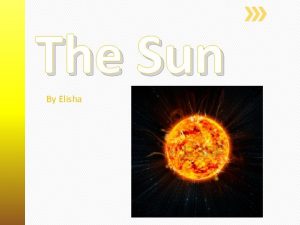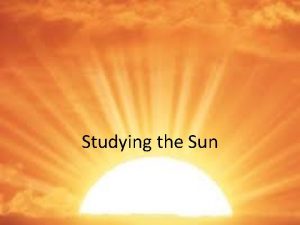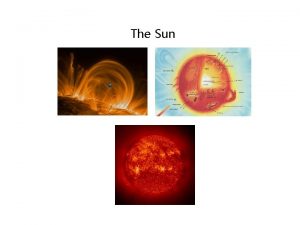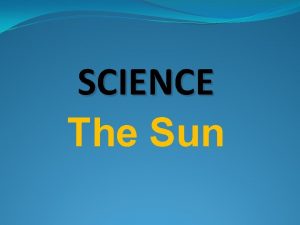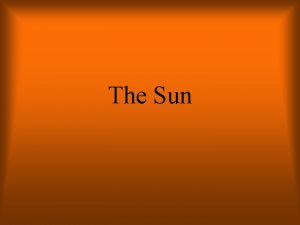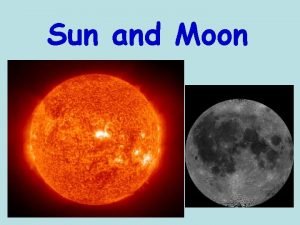2 The Sun as a star General properties
























































- Slides: 56

2. The Sun as a star General properties, place in the Hertzsprung. Russell diagram. Distance, mass, radius, luminosity, composition, age, evolution, spectral energy distribution.

General Properties of the Sun. Hertzsprung-Russel Diagram. Sun Hertzsprung-Russel Diagram. Numbers in the mainsequence band stars are stellar masses in units ofcatalog the solar mass. 22, 000 from Hipparcos Dotted lines correspond to constant radius in units of the solar radius. RW - radiatively driven wind. • In 1911 -13, Ejnar Hertzsprung and Henry Norris Russell independently developed H-R diagram • Horizontal axis - spectral type (or, equivalently, color index or surface temperature) • Vertical axis - absolute magnitude (or luminosity) • Data points define definite regions, suggesting common relationship exists for stars composing region. Each region represents stage in evolution of stars. • The place of a star on the H-R diagram also tells us about its radius, energy generation and transport, periods and growth rates of pulsations, rotation rate, stellar activity, X-ray coronas, etc. • Sun is G 2 main-sequence star. Lies roughly in middle of diagram among what are referred to as yellow dwarfs.

Overall properties

Sun’s age Radioactive decay Does not change over time Measured by mass spectrometer

The age is determined from the slope

New solar parameters adopted by the International Astronomical Union (2015)

Distance - I

Distance - II Kepler’s law Triangulation Measure the distance between the planets, D, the orbital periods, t 1 and t 2, and then calculate their distances to the Sun, a 1 and a 2.

Distance - III The Sun's angular size varies from 31' 27. 7" to 32' 31. 9" during the course of a year because the distance changes from 1. 471 x 1011 m in January to 1. 521 x 1011 m in July. 1 arcsec varies from 710 km to 734 km.

The Solar Mass

Sun’s rotation axis is inclined by 7. 23 degrees to the ecliptic

Solar coordinates • P-angle (or P): The position angle between the geocentric north pole and the solar rotational north pole measured eastward from geocentric north. The range in P is +/- 26. 31 degrees. • B 0: Heliographic latitude of the central point of the solar disk; also called the Bangle. The range of B 0 is +/- 7. 23 degrees, correcting for the tilt of the ecliptic with respect to the solar equatorial plane. • L 0: Heliographic longitude of the central point of the solar disk. The longitude value is determined with reference to a system of fixed longitudes rotating on the Sun at a rate of 13. 2 degrees/day (the mean rate of rotation observed from central meridian transits of sunspots). The standard meridian on the Sun is defined to be the meridian that passed through the Sun's equator on 1 January 1854 at 1200 UTC and is calculated for the present day by assuming a uniform sidereal period of rotation of 25. 38 days. (Carrington longitude).

The Solar Radius

Determination of the seismic radius

Helioseismic estimate of the solar radius

Measurements of f-mode frequencies and comparison with solar models f-mode

Calibration of solar models to match the helioseismology data Old standard model Seismic radius


Radiative transfer calculations to determine the precise surface location At the limb we see higher layers of the solar atmosphere because of the higher optical depth. The reference wavelength is 5000 A. To observer atmosphere

The apparent solar radius depends on wavelength (the standard value is for 5, 000 A=500 nm) Radio EUV V Rozelot, Kosovichev, Kilcik, 2015

Oblateness

Quadrupole moment

Composition

The Periodic Table for Astronomy

Solar composition • Solar (stellar) composition is determined by the fractional percentage of hydrogen, X, helium, Y, and the heavier elements, Z: • X+Y+Z=1 • X=m. H/M (M is the total mass) • Y=m. He/M • Z=1 -X-Y Canonical values: Hydrogen mass fraction Helium mass fraction Heavy elements Logarithmic abundances are defined relatively to the number density of hydrogen: log e. X=log(NX/NH)+12 NX – number density of element X NH – number density of hydrogen H Stellar “metallicity” is defined relative to the Sun [Fe/H]: measured in dex (e. g. if [Fe/H]=-1 the number density is 10 times smaller than on the Sun).

Determination of solar (stellar) abundances Recent development of 3 D models

10 7 1 million K 60, 000 K 6, 000 K Temperature (K) 3 million K Corona n. H 10 6 T 10 5 10 4 10 3 10 16 10 Transition Region Chromosphere 14 10 12 10 10 10 8 10 2 10 3 10 4 Height Above Photosphere (km) 10 5 -3 Total Hydrogen Density (cm ) Temperature & Density Structure of the Solar Atmosphere

3 D realistic simulation of the solar surface take into account all essential physics: stratification, gravity, radiative energy transfer, ionization, detailed chemical composition Vz T Only small surface areas can be simulated on modern supercomputers

Example of fitting synthetic spectral line of Fe I from 1 D and 3 D models to observations Much better fit with the 3 D model

Illustration of the solar abundances (mass fractions) X Y Hydrogen Helium Z Oxygen The result of the 3 D models was a substantially lower abundance of the heavy elements: Z=0. 014 instead of 0. 02 found using 1 D models.

The low Z led to a “crisis” in helioseismology and solar modeling • For a given chemical composition, X, Y, Z, the structure of the Sun is calculated using the Standard Stellar Evolution Theory. • The distribution of the sound speed as a function of radius is determined by helioseismology, and can be compared with the solar model. • For Z=0. 02 the solar model is in excellent agreement with helioseismology. • However, for Z=0. 014 the disagreement is very large. The source of discrepancy is still unknown. Asplund, Grevesse & Sauval, 2005 -9 Z=0. 014 Z=0. 02 Grevesse & Sauval, 1998

Luminosity Absorption in the Earth’s atmosphere. The edge of the shaded area marks the height where the radiation is reduced to 1/2 of its original strength. UV - ultraviolet; V- visible; IR infrared.

Irradiance variations The composite total irradiance from 1977 to 2018. Note the variation with the solar activity cycle of order 0. 1%

Faint young Sun paradox • The Standard Stellar Evolution theory shows that the Sun’s luminosity increased by 28% over the Sun’s life of 4. 6 billion years. • If the solar energy output was 28% lower then oceans would freeze. But geological records show that this was not the case, and the surface was warm. • Possible solutions: – Earth’s atmosphere had more greenhouse gases – Earth produced more internal heat – The Sun was more massive, and lost mass because of strong solar wind – this is a hot topic of current research in astronomy (“The Sun in Time” project).

Effective temperature of the Sun

Spectral energy distribution

Solar irradiance spectrum 1 Angstrom = 10 -10 m = 10 -8 cm = 0. 1 nm = 10 A

Black body radiation Black body spectrum depends only on temperature


Spectral energy distribution

Visible spectrum H-alpha line 6563 A

Hydrogen series Lya Ha Hb Hg

Visible spectrum Hb Hg Ca. II H&K Ha line 6553 A

Ha image from BBSO September 9, 2018

Magnetogram SDO/HMI

Continuum Image SDO/HMI

Visible solar spectrum with absorption (Fraunhofer) lines

Different parts of Fraunhofer lines are formed in different layers: the line core is formed higher than the line wings

VAL (Vernazza, Avrett, Loeser) model of the solar atmosphere

Color indices

Infrared spectrum The infrared spectral irradiance.

Radio spectrum

UV spectrum Lya

EUV and X-ray spectrum

X-ray emission is highly variable Soft X-ray from GOES satellite (last 2 days)

Real-time solar images http: //jsoc. stanford. edu/data/hmi/images/latest/ http: //sdowww. lmsal. com/suntoday/ http: //helioviewer. org/ http: //www. bbso. njit. edu/cgi-bin/Latest. Images http: //sohowww. nascom. nasa. gov/ http: //www. raben. com/maps/
 Star of wonder star of night star of royal beauty bright
Star of wonder star of night star of royal beauty bright A* and ao*
A* and ao* Fccla star events
Fccla star events Distance from the sun saturn
Distance from the sun saturn Stars larger than the sun
Stars larger than the sun The sun compared to other stars
The sun compared to other stars Star sun solar
Star sun solar Key properties of the progenitor star
Key properties of the progenitor star Characteristics of the sun
Characteristics of the sun Extensive vs intensive properties
Extensive vs intensive properties Chemical properties of citric acid
Chemical properties of citric acid Hình ảnh bộ gõ cơ thể búng tay
Hình ảnh bộ gõ cơ thể búng tay Slidetodoc
Slidetodoc Bổ thể
Bổ thể Tỉ lệ cơ thể trẻ em
Tỉ lệ cơ thể trẻ em Voi kéo gỗ như thế nào
Voi kéo gỗ như thế nào Tư thế worms-breton
Tư thế worms-breton Chúa sống lại
Chúa sống lại Các môn thể thao bắt đầu bằng tiếng chạy
Các môn thể thao bắt đầu bằng tiếng chạy Thế nào là hệ số cao nhất
Thế nào là hệ số cao nhất Các châu lục và đại dương trên thế giới
Các châu lục và đại dương trên thế giới Công thức tính thế năng
Công thức tính thế năng Trời xanh đây là của chúng ta thể thơ
Trời xanh đây là của chúng ta thể thơ Mật thư tọa độ 5x5
Mật thư tọa độ 5x5 Làm thế nào để 102-1=99
Làm thế nào để 102-1=99 Phản ứng thế ankan
Phản ứng thế ankan Các châu lục và đại dương trên thế giới
Các châu lục và đại dương trên thế giới Thơ thất ngôn tứ tuyệt đường luật
Thơ thất ngôn tứ tuyệt đường luật Quá trình desamine hóa có thể tạo ra
Quá trình desamine hóa có thể tạo ra Một số thể thơ truyền thống
Một số thể thơ truyền thống Cái miệng bé xinh thế chỉ nói điều hay thôi
Cái miệng bé xinh thế chỉ nói điều hay thôi Vẽ hình chiếu vuông góc của vật thể sau
Vẽ hình chiếu vuông góc của vật thể sau Nguyên nhân của sự mỏi cơ sinh 8
Nguyên nhân của sự mỏi cơ sinh 8 đặc điểm cơ thể của người tối cổ
đặc điểm cơ thể của người tối cổ V cc cc
V cc cc Vẽ hình chiếu đứng bằng cạnh của vật thể
Vẽ hình chiếu đứng bằng cạnh của vật thể Phối cảnh
Phối cảnh Thẻ vin
Thẻ vin đại từ thay thế
đại từ thay thế điện thế nghỉ
điện thế nghỉ Tư thế ngồi viết
Tư thế ngồi viết Diễn thế sinh thái là
Diễn thế sinh thái là Dạng đột biến một nhiễm là
Dạng đột biến một nhiễm là Số nguyên tố là
Số nguyên tố là Tư thế ngồi viết
Tư thế ngồi viết Lời thề hippocrates
Lời thề hippocrates Thiếu nhi thế giới liên hoan
Thiếu nhi thế giới liên hoan ưu thế lai là gì
ưu thế lai là gì Hổ đẻ mỗi lứa mấy con
Hổ đẻ mỗi lứa mấy con Sự nuôi và dạy con của hươu
Sự nuôi và dạy con của hươu Sơ đồ cơ thể người
Sơ đồ cơ thể người Từ ngữ thể hiện lòng nhân hậu
Từ ngữ thể hiện lòng nhân hậu Thế nào là mạng điện lắp đặt kiểu nổi
Thế nào là mạng điện lắp đặt kiểu nổi Properties of smart and modern materials
Properties of smart and modern materials Properties of gas
Properties of gas 12 properties of matter
12 properties of matter Common properties of matter
Common properties of matter



